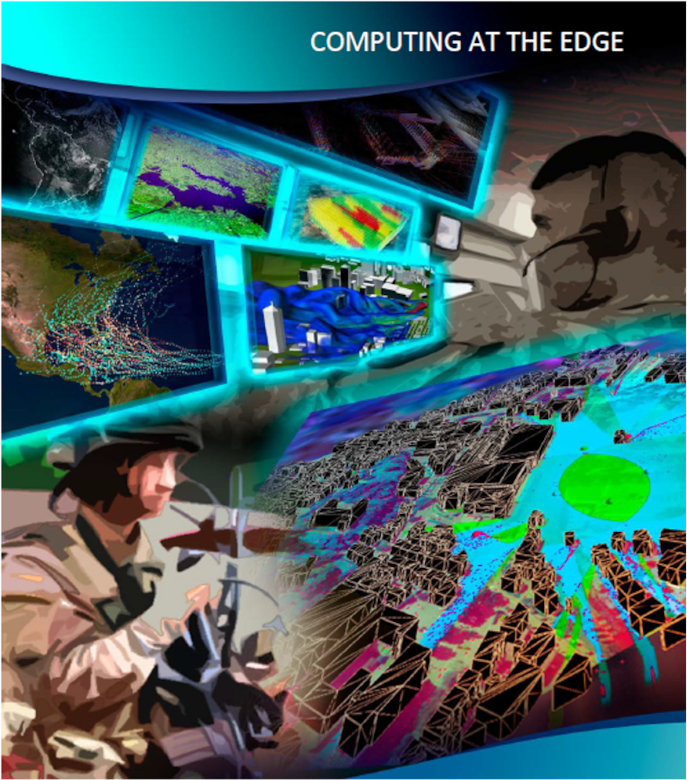®
Home/ Media / Megan Saxton
U.S. ARMY ENGINEER RESEARCH AND DEVELOPMENT CENTER
Published Sept. 23, 2024
Updated: Sept. 23, 2024
PHOTO DETAILS / DOWNLOAD HI-RES 1 of 1
The U.S. Army Engineer Research and Development Center (ERDC) Information Technology Laboratory (ITL) Edge Computing Lab has long been on the cutting-edge of this field and is now exploring something new: neuromorphic computing.
PRINT | E-MAIL
In recent years, edge computing has revolutionized the technology landscape for users situated in remote areas or away from primary devices. By bringing computation and data storage closer to the location where it is needed, response times, reliability and performance are greatly improved, latency and bandwidth costs are reduced and privacy and security are enhanced. The U.S. Army Engineer Research and Development Center (ERDC) Information Technology Laboratory (ITL) Edge Computing Lab has long been on the cutting-edge of this field and is now exploring something new: neuromorphic computing.
“Neuromorphic computing is a process in which computers are designed and engineered to mirror the structure and function of the human brain,” said Dr. Raju Namburu, ITL chief technology officer and a senior scientific technical manager. “Using artificial neurons and synapses, neuromorphic computers simulate the way our brains process information, allowing them to solve problems, recognize patterns and make decisions more quickly and efficiently than the traditional high-performance computing systems we use today.”
The driving force behind ITL’s research into this emerging technology is the U.S. military’s need to know more, sooner, to allow rapid, decisive action on the multi-domain battlefield. The battlespace has become characterized by highly distributed processing, heterogeneous and mobile assets with limited battery life, communications- dominated but restricted network capacity and operating with time-critical needs in a rapidly changing hostile environment. Distributed and low power edge processing is one of the essential technologies for maintaining overmatch in various emerging operational and contested environments, as is the need to take advantage of machine learning (ML) and generative artificial intelligence (AI).
“Overall, neuromorphic chips offer the DoD community a number of potential benefits including improved performance, resilience, cost-efficiency, security, privacy, power-efficiency, signal processing, ML capabilities and more,” said Dr. Ruth Cheng, a computer scientist in ITL’s Supercomputing Research Center. “By keeping an eye on developments in this technology, the DoD community can ensure it remains at the forefront of military and defense innovation.”
“Computations performed at the molecular, atomic, and neuro scales mimicking the human brain are showing tremendous viability,” added Namburu. “We just started this work on next generation advanced computing, which is significantly different from traditional computing systems historically used at ERDC. Neuromorphic computing represents a paradigm shift in computing, promising significant advancements in ML, generative AI, scientific applications and sensor processing compared to traditional computing. Moreover, neuromorphic chips emulate the brain's plasticity, enabling learning and adaptation over time, unlike traditional systems.”
Ongoing efforts edge computing efforts include agnostic graphics processing unit (GPU) ray tracing development, benchmarking deep neural networks, sensor-data management, ML for underwater invasive plants, railcar inspection, photogrammetry, reservoir frameworks, decentralized edge computing, bi-directional digital twins and algorithms for anomaly detection. ITL is also exploring emerging AI chips for edge computing including novel algorithms and sustainable software.
“Overall, edge computing is helping to enable new use cases and provide better experiences to the users by making applications faster, more reliable and more secure,” said Cheng. “Neuromorphic chips are well-suited for edge computing, which is becoming increasingly important in military and defense applications, and ITL is already aiding in this process that will touch everything from lowering the cost of deployments by eliminating the need for expensive, high-powered servers and data centers to support of mobile and autonomous systems. This is the future.”
- Forums
- ASX - By Stock
- BRN
- 2024 BrainChip Discussion
2024 BrainChip Discussion, page-9988
-
- There are more pages in this discussion • 1 more message in this thread...
You’re viewing a single post only. To view the entire thread just sign in or Join Now (FREE)
Featured News
LU7
Discover the strong preliminary feasibility of the Bécancour Lithium Refinery, showcasing resilience in a low pricing environment and a strategic plan to capitalize on future price recoveries
Add BRN (ASX) to my watchlist
 (20min delay) (20min delay)
|
|||||
|
Last
23.0¢ |
Change
0.000(0.00%) |
Mkt cap ! $451.3M | |||
| Open | High | Low | Value | Volume |
| 23.0¢ | 24.0¢ | 21.5¢ | $2.863M | 12.69M |
Buyers (Bids)
| No. | Vol. | Price($) |
|---|---|---|
| 6 | 136498 | 23.0¢ |
Sellers (Offers)
| Price($) | Vol. | No. |
|---|---|---|
| 23.5¢ | 444756 | 13 |
View Market Depth
| No. | Vol. | Price($) |
|---|---|---|
| 5 | 116498 | 0.230 |
| 4 | 205000 | 0.225 |
| 23 | 689438 | 0.220 |
| 22 | 1098412 | 0.215 |
| 38 | 1026309 | 0.210 |
| Price($) | Vol. | No. |
|---|---|---|
| 0.235 | 444756 | 13 |
| 0.240 | 941937 | 20 |
| 0.245 | 612347 | 15 |
| 0.250 | 151787 | 5 |
| 0.255 | 132485 | 7 |
| Last trade - 16.10pm 04/10/2024 (20 minute delay) ? |
Featured News
| BRN (ASX) Chart |











